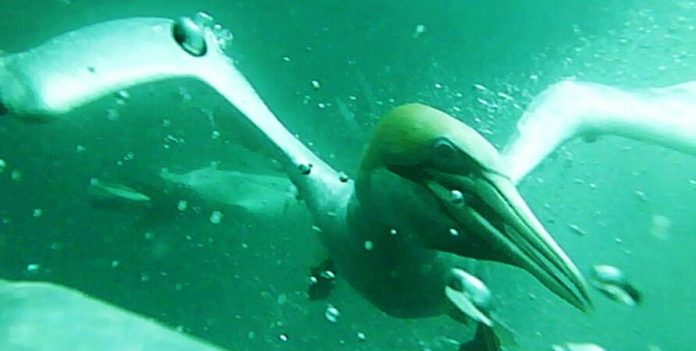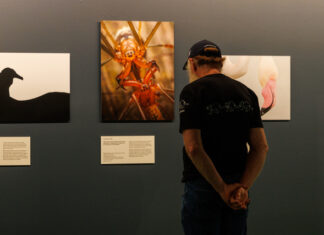DEAKIN University researchers have been given a bird’s-eye view of Port Phillip Bay and other Victorian underwater kingdoms, after attaching miniature video cameras to seabirds in a bid to work out how they find food in different environments.
The researchers from Deakin’s Centre for Integrative Ecology, within the School of Life and Environmental Sciences, filmed bird behaviour at two different marine environments so they could work out if they used different hunting strategies in different settings.
Researcher Melanie Wells, who completed the study for her honours thesis project, placed the cameras on the Australasian gannets at the Pope’s Eye Marine Reserve, in Port Phillip Bay, and at Point Danger, Australia’s only mainland colony of the seabirds, just outside Portland in southwest Victoria.
“Our footage gave a unique insight into the behaviour of Australasian gannets, revealing previously unknown information about their foraging behaviour and, importantly, showed they can adapt their hunting strategies to suit available resources and environmental conditions,” Ms Wells said.
“We discovered a previously undescribed hunting strategy for these birds which, interestingly, appears to be gender-specific.
“All the birds at Point Danger fed offshore on small schooling fish like pilchards and anchovies with other gannets, usually in association with other marine predators like dolphins and seals that collect the prey into bait balls which are herded to the surface.
“Our cameras showed the birds could swim underwater to capture several small fish per dive. This behaviour is common for gannet species around the world.”
But Ms Wells said at Popes Eye, the research team was surprised to find a different story.
“There, half of the study birds hunted in the same way in Bass Strait, but the other half hunted within Port Phillip Bay and were observed to be foraging alone,” Ms Wells said.
“Interestingly, 93 per cent of birds feeding in the bay were male.”
Ms Wells said the birds that hunted in the bay followed sandbanks in very shallow waters and didn’t rely on other predators, such as dolphins, to drive prey to the surface.
“Our cameras showed the birds were literally searching the shallow waters for food, possibly detecting the silhouettes of prey against the sea floor much like a coastal patrol plane finds sharks. They tended to catch one single large fish at a time,” she said.
“This study has helped us understand the diversity of behaviours, and the influence of gender and environment, when it comes to searching for food in this species.”
Ms Wells’ research supervisor, Deakin marine scientist Associate Professor John Arnould said seabirds were highly sensitive to environmental variability, making them ideal biological indicators of ecosystem health.
“With a changing climate, the oceanic regime of south-eastern Australia is also changing. It is largely unknown how biological communities, and in particular top predators such as seabirds, may respond to these changes,” Associate Professor Arnould said.
“Determining the suite of behaviours animals have in relation to normal environmental variability is crucial for being able to predict how they may respond to future changes.
“The results of this study demonstrate strong behavioural variability in Australasian gannets which suggests plasticity in foraging behaviours, essential in the response and adaptation to environmental change.”
Associate Professor Arnould’s team will conduct further studies over the coming years to determine the degree and consistency of individual foraging specialisations and how this impacts breeding success. Of particular interest is whether age and experience influences foraging specialisations.
Watch the video here: phys.org/news/2015-06-miniature-video-cameras-seabirds.html#jCp







